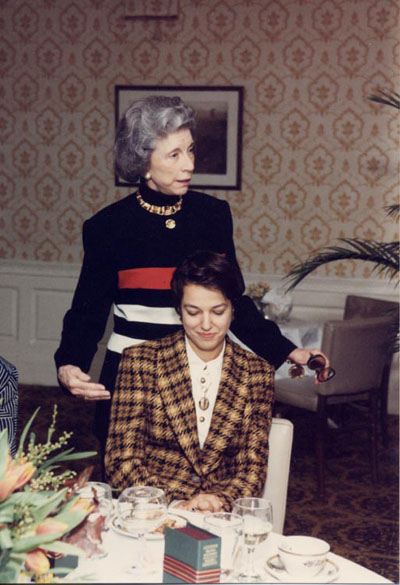I am greatly fortunate to have had Betty Ring as a teacher and a mentor. Betty instilled in me an approach to the field of American samplers and schoolgirl needlework that was both unique and invaluable, and she taught me important lessons that extended beyond the material which she loved. Over a period of almost 20 years, beginning in the mid-1980s, I was in constant communication with Betty, and fortunately preserved most of the letters she sent to me. Some are typewritten and some are handwritten, these letters are Betty’s legacy to me. Reviewing them recently has reminded me how important she was to my education over those many years; the detailed and, needless-to-say, very interesting information that she graciously provided was extraordinary. Of course, these letters also demonstrate the energy and exceptional scholarship which she brought to this field and her unselfish willingness to share information with others.
In one particular letter Betty provided me with many specifics as a follow-up to a delightful two day working visit to my shop, and she ended the letter by graciously thanking me for my time. She indicated how much she had enjoyed seeing all of the interesting material that I had; she then, most importantly, wrote the following, providing insight into her remarkable passion:
“American samplers are an ever-unfolding field filled with endless surprises – I can never tire of it!”
We are all very fortunate that Betty felt as strongly as she did about her field of interest, and that she has been able to devote so many years to collecting, researching and writing.
One of the themes that emerge from the years of correspondence is the deep and abiding commitment she made to her scholarship. Within one letter she demonstrated her diligence and pursuit of knowledge as follows:
“I’m finally back in Houston with unpacked boxes and crates of samplers and silk embroideries sitting around while I work frantically to try to revise my book. The days and nights all seem to run together because I almost never leave this desk!”
Betty’s letters and life indicate that she hasn’t had enough time to complete all that she wished to achieve, even though all who know her are astounded at how much she has accomplished. She frequently spoke and wrote about her desire to research, analyze and write a great deal more:
“Actually, I had so much to work on that I didn’t manage to get to all of it and would love to have had at least two more days to spend at the Genealogical Society.”
“I’m not satisfied with what little I learned about [a certain group of 18th century samplers] when I was in Philadelphia not long ago, but time ran out before I could think of a new approach. There is so much more I hope to do.”
Betty constantly sought to obtain new information – asking me in one letter for a copy of a photo of a specific sampler because she never had seen such an example before and wanted to include it in a footnote in her book. I was always deeply flattered when I could add to her unusually comprehensive files.
For a person who demonstrated such encyclopedic knowledge of the field, her humility was a lesson worth learning. For example, when discussing an exciting new discovery and trying to establish the genealogy of the maker, she wrote to me as follows:
“It seems that every day I know less than I knew the day before!! Samplers are so vast in number and endless in variety, and after all of these years, I seemed to have barely scratched the surface of their history. If I come across any new clues about this piece, I will let you know.”
How remarkable for someone with Betty’s vast knowledge to be so humble about her position and accomplishments. Throughout the many years of our friendship, I came to understand that it was this humility that drove her to learn more and more and to have seemingly inexhaustible energy in her pursuit of knowledge. Betty evidenced a constant willingness to help others unravel the mystery of a sampler, samplermaker, teacher, school or group of schoolgirl work.
And her correspondence also indicates other characteristics worth noting.
While our letters related almost exclusively to the pursuit of information about a particular needleworker or sampler, a specific exhibition or publication, she would occasionally diverge from these subjects. One communication ended with the comment “I have all of my five sons here right now so I must stop.” We in the field who have revered her as a scholar could forget that she is a devoted wife and mother, and that she was deeply involved with her family. In conversation, Betty and I frequently covered the details of her large family.
I have a handwritten note in which she described to me her upcoming plans for a research trip to the Philadelphia region, and in which she also found the time to write about the beauty of her beloved Texas:
“I’ve just driven home from my farm house where the hills and dales are covered with every variety of Texas wildflowers – just a gorgeous spring day – trees all fully foliated now.”
Betty has always been extraordinarily kind and willing to acknowledge and praise others. In a letter discussing a particular white-work Philadelphia sampler, she praised the renowned Scottish needlework scholar who had helped her in her pursuit of the understanding of this complicated technique:
“Margaret Swain is such a wonderful person and always so generous with her knowledge, which is vast. She was marvelous about helping me sort out the many different descriptions of ‘Dresden work’ for my book.”
Those same words could be said about Betty Ring, a wonderful person who has always been so generous with her knowledge and whose knowledge is vast.

Betty and Amy at a dinner, in 1993, honoring the publication of Betty's new books: Girlhood Embroidery
